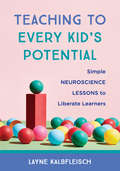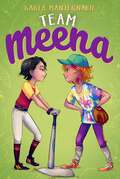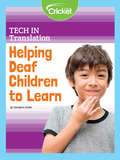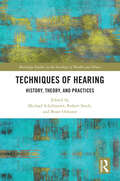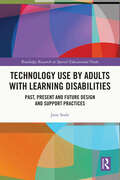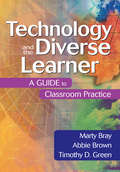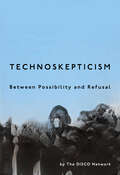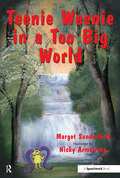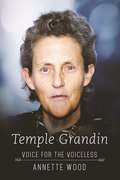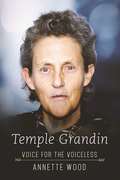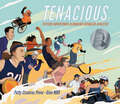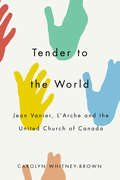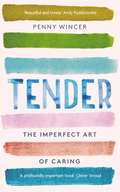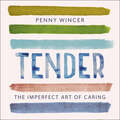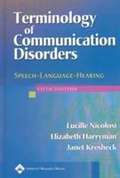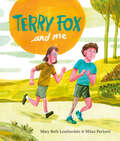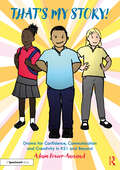- Table View
- List View
Teaching to Every Kid's Potential: Simple Neuroscience Lessons To Liberate Learners
by Layne Kalbfleisch MED, PhD“Teachers hold the potential to provide a student with frustration or opportunity every day—and those states are closer together than you might think.” When students repeatedly lose track of directions or take a long time to solve problems, it’s easy for teachers to see the distracted or off-task behavior, but not always to see the root of the problem. Quite often the same child who has an underdeveloped skill may have an opposing but hidden strength: a slow processor of information may also be a deep thinker. Teaching to Every Kid’s Potential is an invitation to teachers to improve the learning in their classrooms, one student at a time, using practical, evidence-based strategies. Focusing on four big concepts from neuroscience—flexibility, readiness, connection, and masking—the author shows how to apply them to build on the strengths of students. Each chapter unpacks the science; shows how talents can compensate for neural processing issues and suggests small but powerful adjustments to classroom practice that can allow kids’ gifts to emerge.
Team Interpreting
by Jack HozaThis book is about how interpreters work together in teams. Much has been written about the process by which an interpreter determines equivalent meaning in the target language, and how interpreters manage their work and make important professional, ethical, and meaning-based decisions. Although team interpreting is commonplace in interpreting assignments that are lengthy, complex, or particularly challenging, little study has been made of this important feature of the interpreting profession. Teaming has the potential to enrich the interpretation, provide additional support for the interpreters, and enable participants in the interpreted interaction to better achieve their goals. This book represents the first major published volume that addresses team interpreting.
Team Meena (The Meena Zee Books)
by Karla Manternach&“For Junie B. graduates&” (Kirkus Reviews), the fourth and final novel in the Meena Zee series follows irrepressible Meena as she maintains a long-distance friendship with Sofía and makes new friends.No one can take Sofía&’s place. Now that her best friend lives across the country, everything reminds Meena of her. She even spends the whole week saving up things to tell Sofía in their Saturday video chats. But when Sofía gets busy with soccer friends, Meena decides to join a team of her own. Only it turns out softball is harder than she expects. So is getting along with Lin, her bossy teammate who doesn&’t even like art! It&’s not like Meena wants to be friends or anything. She still has Sofía, doesn&’t she? But can they stay close when they&’re so far apart, or is it time to expand Team Meena?
Teamwork II
by Stewart Nordensson Lydia KelleyTeamwork II is the second book designed to help people with disabilities train their dogs- Teamwork II focuses specifically on service dog skill training. It is a good resource for anyone considering owner training or private training or even for people with program trained dogs to add further skills to their dogs training.
Teamwork: A Dog Training Manual for People with Disabilities
by Stewart Nordensson Lydia KelleyThis manual explains the exercises of "sit" "stay" "down" "come, and a varity of more, with ideas on how to train them with a physical disability. This book proves that it is not the "method" that makes the training successful but the trainer and the dog. Topics covered include, equipment, different adaptations, food in training, teaching the "leave it" command. And talks about basic Service dog training.
Tech in Translation
by Carollyne HutterIn Morocco, deaf children were at a disadvantage when it comes to their education. When Dr. Abdelhadi Soudi built a computer program that can translate sign language, it improved the way Morocco teaches their deaf children by leaps and bounds!
Techniques Used By Blind Cane Travel Instructors: Learning, Teaching, Believing
by Maria Morais Paul Lorensen Roland Allen Edward C. Bell Arlene Hill Eric WoodsBlind individuals employed as mobility specialists describe the techniques that are effective for them.
Techniques of Hearing: History, Theory and Practices
by Michael Schillmeier, Robert Stock, and Beate OchsnerHearing, health and technologies are entangled in multi-faceted ways. The edited volume addresses this complex relationship by arguing that modern hearing was and is increasingly linked to and mediated by technological innovations. By providing a set of original interdisciplinary investigations that sheds new light on the history, theory and practices of hearing techniques, it is able to explore the heterogeneous entanglements of sound, hearing practices, technologies and health issues. As the first book to bring together historians, scholars from media studies, social sciences, cultural studies, acoustics and neuroscientists, the volume discusses modern technologies and their decisive impact on how ‘normal’ hearing, enhanced and smart hearing as well as hearing impairment have been configured. It brings both new insights into the histories of hearing technologies as well as allowing us to better understand how enabling hearing technologies have currently been unfolding an increasingly hybrid ecology engaging smart hearing devices and offering stress-free hearing and acoustic wellbeing in novel auditory environments. The volume will be of interest to all scholars and students of disability studies, sound studies, sociology of health and illness, medical history, health and society as well as those interested in the practices and techniques of self-monitored and smart hearing.
Technology Use by Adults with Learning Disabilities: Past, Present and Future Design and Support Practices (Routledge Research in Special Educational Needs)
by Jane SealeThis book examines the role that technologies play in the lives of adults with learning disabilities. It analyses how design and support practices can be used to support access to technology in ways that can enhance opportunities and life experiences. Drawing on international literature and the author’s own research, the book considers what we know about past and present practices of supporting adults with learning disabilities to use technologies. It outlines how support practices can offer opportunities to overcome digital inequalities, offering a framework of core beliefs and knowledge that can inform future initiatives. The book has a particular focus on technologies, policies, practitioner communities and the characteristics of support practice. It also highlights the potential of people with learning disabilities, the potential of technology and the potential of the environment to support technology use. This important book will be highly relevant reading for academics, researchers and post-graduate students in the field of special educational needs and disabilities, digital education and learning technologies, inclusive education and social work.
Technology and the Diverse Learner: A Guide to Classroom Practice
by Marty Bray Professor Abbie Brown Dr Timothy Tim GreenSpecifically designed for the K-12 inclusive classroom, this timely handbook demonstrates how to easily and effectively capitalize on available technology.
Technology for All Assistive Technology in the Classroom
by Overbrook School for the BlindAn easy-to-read, field tested resource for all schools and colleges that need assistive technology in the classroom.
Technoskepticism: Between Possibility and Refusal (Sensing Media: Aesthetics, Philosophy, and Cultures of Media)
by DISCO NetworkFrom Munchausen by Tiktok to wellness apps to online communities to AI, the DISCO Network explores the possibilities that technoskepticism can create. This is a book about possibility and refusal in relation to new technologies. Though refusal is an especially powerful mode—particularly for those who have historically not been given the option to say no—people of color and disabled people have long navigated the space between saying yes and saying no to the newest technologies. Technoskepticism relates some of these stories to reveal the possibilities skepticism can create. The case for technoskepticism unfolds across three sections: the first focused on disability, the creative use of wellness apps, and the desire for diagnosis; the second on digital nostalgia and home for Black and Asian users who produced communities online before home pages gave way to profiles; and the third focused on the violence inherent in A.I.-generated Black bodies and the possibilities for Black style in the age of A.I. Acknowledging how the urge to refuse new technologies emerges from specific racialized histories, the authors also emphasize how care can look like an exuberant embrace of the new.
Teenie Weenie in a Too Big World: A Story for Fearful Children (Helping Children with Feelings)
by Margot Sunderland(A story for fearful children) One day Teenie Weenie finds himself in a scrumbly screechy place. It is full of noises and crashes and things that swoop and scratch. The worse it gets, the smaller Teenie Weenie feels. After a while, he feels so small that the tiniest insect tries to eat him up. Teenie Weenie feels terrified and desperately alone. But after a while along strolls a Wip-Wop bird who invites Teenie Weenie to come and have a chocolate muffin in his tree house. With the Wip Wop bird and his friend Hoggie, Teenie Weenie learns for the first time in his life all about the power of TOGETHER. He comes to know how very different things look when it's an US not just a ME. And so after that, whenever Teenie Weenie finds himself struggling alone with something too difficult or too frightening, he goes off and finds some TOGETHER.
Temple Grandin: Voice for the Voiceless
by Annette WoodSince Temple Grandin's life story was told in the 15 x Emmy-nominated film Temple Grandin, and since her heartwarming speech at the award ceremony, she has become one of the world's most well-known members of its community. In this fascinating biography, Annette Wood delves deep into Grandin's life from childhood to adulthood. Wood tells of the trials and tribulations of the icon: What difficulties Grandin struggled with and how she's become a hero for the autistic community. She also tells what Temple has done since the movie came out, where she is today, what kind of difference she's made, and what her future holds. For the 22 million people worldwide afflicted by autism and the countless friends and family members who support them, this brilliant portrait presents an up-close look at the disorder and renewed hope for what the future could bring for those on all levels of the spectrum.
Temple Grandin: Voice for the Voiceless
by Annette WoodSince Temple Grandin's life story was told in the 15 x Emmy-nominated film Temple Grandin, and since her heartwarming speech at the award ceremony, she has become one of the world's most well-known members of its community. In this fascinating biography, Annette Wood delves deep into Grandin's life from childhood to adulthood. Wood tells of the trials and tribulations of the icon: What difficulties Grandin struggled with and how she's become a hero for the autistic community. She also tells what Temple has done since the movie came out, where she is today, what kind of difference she's made, and what her future holds. For the 22 million people worldwide afflicted by autism and the countless friends and family members who support them, this brilliant portrait presents an up-close look at the disorder and renewed hope for what the future could bring for those on all levels of the spectrum.
Ten Fingers for God: The Complete Biography of Dr. Paul Brand
by Dorothy C. WilsonTen Fingers for God describes the extraordinary servanthood--the life of Dr. Paul Brand, a medical doctor, whose life and work have been a blessing to countless thousands of leprosy victims on five continents. Through surgeries (over 3,000 in India alone), the pioneering research he has conducted and inspired, and his empathy for the poor and forsaken. Dr. Brand has achieved fame in the medical world. Dr. Brand's professional life has centered on perhaps the most problematic aspect of creation, the existence of pain. His conviction that the function of pain in the human body is a disguised blessing to the human race. He felt that "God designed the human body so that it is able to survive because of pain. As a surgeon, teacher, and environmentalist. Dr. Brand 'has chosen the middle way of balancing the material and the mystical, the prophetic and the pragmatic. His spirit of self-sacrifice and humility can best be distilled by his sureness that "it is a pity that a man has only one life to spend, one pair of feet, two hands, ten fingers! Paul Brand is an adventure loving, highly spiritual surgeon who discovers his life's calling is to improve the hands and feet of people with leprosy worldwide. He developed techniques for returning functionality to disfigured, numb hands and feet and goes on to establish centers where patients receive protective shoes and learn skills to become employable. Paul both teaches others in many countries to help in his mission and learns from other doctors, scientists and rehabilitation specialists. In his travels and impassioned, informative speeches he raises awareness of this disease which is only contagious for a brief time and inspires people to pool their resources to improve care for a population ending their generations old fate of being shunned, ostracized and forced to beg for their survival.
Tenacious: Fifteen Adventures Alongside Disabled Athletes
by Patty Cisneros PrevoMeet fifteen remarkable athletes who use adaptive equipment in this beautiful and truth-telling picture book.A downhill skier whose blindness has sharpened her communication skills. An adaptive surfer who shreds waves while sitting down. A young man who excels at wheelchair motocross--but struggles with math. Tenacious tells their stories and more, revealing the daily joys and challenges of life as an athlete with disabilities. These competitors have won gold medals, set world records, climbed mountain peaks, claimed national championships, and many more extraordinary achievements. Get to know them in Tenacious!
Tender Mercies
by Rosellen BrownLaura and Dan Courser are a less than perfect, but deeply passionate couple with two young children and lots of plans. Until Dan, displaying the boyish bravado that made Laura fall in love with him, takes the tiller of a boat he can't handle and causes the accident that changes their lives forever. Suddenly there are no more ordinary days or nights, as two people wrestle with a marriage in which all the rules are changed, confronting the guilt and anger, fear and desire that can tear apart families and lives. some profanity; description of a rape dream; sexual language; some intentional mis-spellings in the book indicate educational and social level TENDER MERCIES In Tender Mercies, the New York Times bestselling author of Before and After creates another heartbreaking portrait of a family in crisis-a haunting, unforgettable novel of love, loss, and healing.
Tender to the World: Jean Vanier, L'Arche, and the United Church of Canada
by Carolyn Whitney-Brown"What is the secret that allows L'Arche to exist? I'll tell you: pleasure!" explains Jean Vanier, founder of the international federation of L'Arche communities where people with and without intellectual disabilities share their lives. Vanier's spiritual vision and playful sense of humour shaped L'Arche, but the organization was also informed by its surprising history with the United Church of Canada. In Tender to the World Carolyn Whitney-Brown explores the connections between the two organizations through diverse critical insights from Julia Kristeva, Doreen Massey, and Mikhail Bakhtin, as well as Vanier's controversial articulation of the gift of weakness. Tracing the five-decade relationship between L'Arche and the United Church alongside evolving disability theories, Whitney-Brown examines both the fundamental importance of stories and the agency of people with intellectual disabilities. Inversion - a transformative overturning of expectations in social interactions - can be upsetting or exciting, challenging or inspiring, she argues. This book offers a fresh look at how L'Arche and the United Church have worked to break down walls of difference, illuminating how each tenders something unexpected to the other and to the world. At a time when many are seeking new visions for society, the long and complex relationship between Canada's largest Protestant denomination and L'Arche offers both encouragement and a deeper way to approach questions of living in diverse communities.
Tender: The Imperfect Art of Caring - 'profoundly important' Clover Stroud
by Penny Wincer'A beautiful and important book that is both deeply engaging and usefully practical. I loved it.' CATHY RENTZENBRINK'An insightful and well-timed book ... forces us to confront the stereotypes - and prejudices - we hold.' SUNDAY TIMES'profoundly important...full of wisdom and bright insights on what it really means to love someone, by a fearless and generous writer. ' CLOVER STROUD'A beautiful and timely reminder that each and every one of us has the ability to care, the capacity for empathy, and the potential to grow.' ANDY PUDDICOMBE, FOUNDER OF HEADSPACE'A wonderful book: compassionate, honest, carefully-reasoned and genuinely helpful... This will benefit many people.' KATHERINE MAY, author of WINTERING 'An invaluable tool for any invisible carers or anyone who wants to learn how to better support their loved ones... we ALL have many, many things to learn from Penny's beautiful, wise, charming, thoughtful words' SCARLETT CURTIS, Sunday Times bestselling author'Moving and beautifully written, nuanced and wise, alert to every paradox at the heart of love. A hugely important book not only for current or future carers, but anyone learning to accept that life tends to resist our control.' OLIVIA SUDJIC, author of EXPOSURE'Tender captures the powerful capacity of people to care for others, and all the heartbreaking and heartwarming complexity that this involves. Penny brings the crucial, yet often overlooked, role of caring into our collective consciousness and, in doing so, demonstrates what it means to be human.' -DR EMMA HEPBURN, author of A TOOLKIT FOR MODERN LIFE'Penny Wincer's TENDER manages to combine both unromanticised honesty about the realities of care with a genuine uplifting hopefulness... is a must-read.' RUTH WHIPPMAN, author of THE PURSUIT OF HAPPINESSWe are all likely - at some point in our lives - to face the prospect of caring for another, whether it's a parent, child or partner. It is estimated that there are 7 million people in the UK caring for loved ones. And yet these are the unpaid, unsung people whose number is rising all the time. In Tender: the imperfect art of caring, Penny Wincer combines her own experiences as a carer with the experiences of others to offer real and transformative tools and insights for navigating a situation that many of us are either facing or will face at some time. Penny Wincer has twice been a carer: first to her mother, and now as a single parent to her autistic son. Tender shows how looking after oneself is a fundamental part of caring for another, and describes the qualities that we can look to cultivate in ourselves through what may otherwise feel to be an exhausting task. Weaving her lived experience with research into resilience, perfectionism and self-compassion, Penny combines the stories of other carers alongside those who receive support - offering an often surprising and hopeful perspective.Penny hosts a podcast Not Too Busy To Write.
Tender: The Imperfect Art of Caring - 'profoundly important' Clover Stroud
by Penny WincerA personal, positive and essential book for the many carers among us. 'A wonderful book: compassionate, honest, carefully-reasoned and genuinely helpful... This will benefit many people.' KATHERINE MAY, author of WINTERING 'An invaluable tool for any invisible carers or anyone who wants to learn how to better support their loved ones... we ALL have many, many things to learn from Penny's beautiful, wise, charming, thoughtful words' - SCARLETT CURTIS, Sunday Times bestselling author'An astonishing book about everyday experience. Moving and beautifully written, nuanced and wise, alert to every paradox at the heart of love. A hugely important book not only for current or future carers, but anyone learning to accept that life tends to resist our control.' - OLIVIA SUDJIC, author of EXPOSURE'Penny Wincer's TENDER manages to combine both unromanticised honesty about the realities of care with a genuine uplifting hopefulness... is a must-read.'- Ruth Whippman, author of THE PURSUIT OF HAPPINESS: WHY ARE WE DRIVING OURSELVES CRAZY AND HOW CAN WE STOP?We are all likely - at some point in our lives - to face the prospect of caring for another, whether it's a parent, child or partner. It is estimated that there are 7 million people in the UK caring for loved ones. And yet these are the unpaid, unsung people whose number is rising all the time. In Tender: the imperfect art of caring, Penny Wincer combines her own experiences as a carer with the experiences of others to offer real and transformative tools and insights for navigating a situation that many of us are either facing or will face at some time. Penny Wincer has twice been a carer: first to her mother, and now as a single parent to her autistic son. Tender shows how looking after oneself is a fundamental part of caring for another, and describes the qualities that we can look to cultivate in ourselves through what may otherwise feel to be an exhausting task. Weaving her lived experience with research into resilience, perfectionism and self-compassion, Penny combines the stories of other carers alongside those who receive support - offering an often surprising and hopeful perspective.
Terminology Of Communication Disorders: Speech-Language-Hearing
by Lucille Nicolosi Elizabeth Harryman Janet KresheckThe leading dictionary/sourcebook of terms for speech, language, and hearing pathology, Terminology of Communication Disorders is intended for students in speech, language, and hearing disorders programs, faculty, and practitioners. Terms are listed alphabetically and cross-referenced for synonyms and related terms, accommodating the sometimes complex classifications of Speech, Language, and Hearing disorders.
Terry Fox and Me
by Mary Beth LeatherdaleCelebrating the 40th anniversary of the Terry Fox Marathon of Hope, this picture book biography tells the story of a friendship defined by strength and love.Before Terry Fox become a national hero and icon, he was just a regular kid. But even then, his characteristic strength, determination and loyalty were apparent and were the foundation for his friendship with Doug. The two first met at basketball tryouts in grammar school. Terry was the smallest - and worst - basketball player on the court. But that didn't stop him. With Doug's help, Terry practiced and practiced until he earned a spot on the team. As they grew up, the best friends supported each other, challenged each other, helped each other become better athletes and better people. Doug was by Terry's side every step of the way: when Terry received a diagnosis of cancer in his leg, when he was learning to walk - then run - with a prosthetic leg and while he was training for the race of his life, his Marathon of Hope. Written from Doug's perspective, this story shows that Terry Fox's legacy goes beyond the physical and individual accomplishments of a disabled athlete and honors the true value of friendship.
Tess: The Story of a Guide Dog
by Peter PurvesThe raising of a guide dog in the United Kingdom. Readers will enjoy the adventures that Tess has, from running away, to eating all sorts of things, and digging up all the flowers. A delightful book for all ages.
That's My Story!: Drama for Confidence, Communication and Creativity in KS1 and Beyond
by Adam Power-AnnandThe ability to communicate is an essential life skill for all children and young people and it underpins their social, emotional and educational development. If a child experiences a positive relationship with an adult listening carefully, they are more likely to constructively share their thoughts, feelings and their imaginative ideas.That’s My Story! places children’s imagined stories at the heart of their own development and provides a joyful, creative approach to support young children’s personal and social development and to encourage their communication. In this book you will find: Tried-and-tested drama games and activities that support communication and well-being, all adaptable to complement your current practice Guidance and advice on how to promote positive adult-child interactions Examples of creative interventions that support children’s communication development A celebration of the joy that comes with carefully listening to children’s own imagined stories Those of us who work with children can sense a tangible connection between how young children feel and how they communicate. This essential and practical resource will be valuable reading for primary teachers, teaching assistants, speech and language therapists, and drama practitioners, as well as outreach and education departments of theatre companies and other arts organisations.
